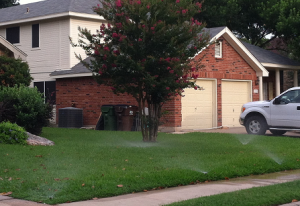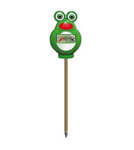
With temperatures beginning to soar into the 90s everyday, we need to start being aware of our water consumption—summer heat is coming! You know it is. Thanks to all the great springtime downpours (and floods!), we have had the luxury of low water bills since we haven’t really needed to turn on the sprinkler (aka: irrigation) system yet this year! In order to prevent a shockingly high bill when you do start using your sprinklers regularly, (remember tiered rates are in effect), here’s my main advice about how to start watering smartly this summer.
So, how do I know if I need to water?
Has it rained recently? If yes, then turn off the sprinklers! We can really keep sprinkler systems turned off for a solid week, or longer, after a good rain event, to let the plants use the rainwater and the soil start to dry out. We want Mother Nature to water our yards, its so much better than tap water thanks to the nitrogen in it AND saves us money. Keep those sprinklers off at least 2 days for every 1/4″ of rainfall.
So, how do you know if your soil is dried out? You can test how wet or dry your soil is with a soil moisture sensor—this is a device for automatic sprinkler systems that is buried in the yard to monitor the soil’s moisture and will either allow or not allow the sprinkler system to run based on how wet the soil is. The City’s Water Conservation Program offers a rebate on this type of device.

You can also test your soil moisture with a soil moisture probe; this is simply a hand-held device that you push into the ground and the display tells you if the soil is wet, moist, or dry. You can find one of these at most garden supply stores. Or, a good old-fashioned long screwdriver will do the job too! If you can easily push it into the ground, then you probably can hold off watering for another couple of days. When you can’t push it easily into the ground, time to water!
And how much do I water?
When you do turn on the sprinklers to start watering, don’t just turn it on full blast to the summer watering schedule—it’s not that hot yet! Keep it moderate, meaning, water on the lower side; about half of your normal summer water schedule. Then as temperatures increase over the rest of the summer, increase the areas that are looking stressed. My recommendation is start with watering no more than once per week. Then, when you notice the lawn or plants look droopy or dull-colored first thing in the morning, that‘s a sign it’s time to increase the water—this could mean add a second watering day, or just increase the time by 2 minutes on the areas that need it.
Remember, the goal is to not have to water! We want to have drought-tolerant plants than need infrequent watering. That happens by letting the soil slightly dry out between watering and getting those roots to grow.
We’re very lucky right now since we’re not under any water restrictions, so watering is allowed on any day. This is great, because it means you can water when your landscape actually needs it, not just because it’s a Tuesday (or whatever day). It’s always best to water before the sun comes up or after the sun goes down each day, to reduce evaporation.
If you are a direct City water customer and your property has an automatic sprinkler system and you are unsure of how to program it or concerned about its efficiency, you can request a free irrigation system evaluation. The evaluation consists of running through the system looking for problems, ways to upgrade or adjust the system to operate more efficiently, and providing recommended water schedules.
To schedule an irrigation evaluation or more water conservation information, contact Jessica Woods by email jwoods@roundrocktexas.gov or 512-671-2872 or visit www.roundrocktexas.gov/conservation for all program information and more detailed recommended watering schedules.


